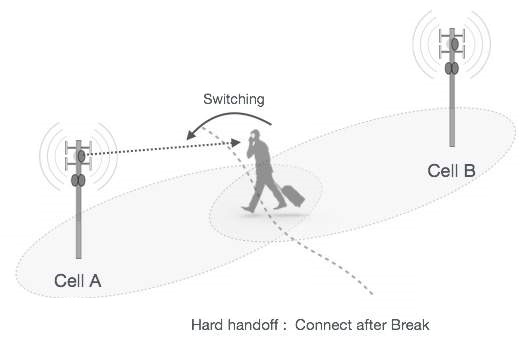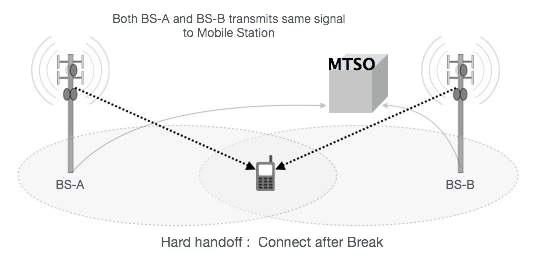
- CDMA Tutorial
- CDMA - Home
- CDMA - Introduction
- CDMA - Channels
- CDMA - Multiple Access Methods
- CDMA - FDMA Technology
- CDMA - TDMA Technology
- CDMA - Technology
- CDMA - Network
- CDMA - Techniques
- CDMA - Spread Spectrum
- CDMA - Fading
- CDMA - Near-Far Problem
- CDMA - Power Control
- CDMA - Frequency Allocation
- CDMA - Handoff
- CDMA - Interferences
- CDMA Questions & Answers
- CDMA - Questions & Answers
- CDMA Useful Resources
- CDMA - Quick Guide
- CDMA - Useful Resources
- CDMA - Discussion
CDMA - Handoff
Whenever a cellular subscriber passes through one base station to another, the network automatically switches to the other respective base station and maintains the coverage responsibility. This behavior called "hand-off" (Handoff) or "hand-over" (Handover).
Whereas in FDMA and TDMA systems, it uses a different frequency to communicate with the base station of that area. It means, there will be a frequency switch from one frequency to another, and during the switching, there will be slightly communication cut, which is called as "hard handoff" (Hard Handoff) or "hard handover" (Hard Handover).
Hard Handoff
In FDMA or TDMA cellular system, a new communication can be established after breaking the current communication at the moment of handoff. Communication between MS and BS breaks at the time of switching the frequency or timeslot.

Soft Handoff
Cellular systems track mobile stations in order to maintain their communication links. When mobile station goes to a neighbor cell, the communication link switches from the current cell to the neighbor cell.

When a mobile enters in a new area (from the base station to another base station), the mobile is the second pilot of sufficient power by sending the message to the strength of the driver to the first base station. The base station notifies the MTSO and then the MTSO requests new Walsh code assignment of the second base station.
The first base station controls with new progressive transfer Walsh assignment MTSO then sends land link to the second base station. Mobile is powered by two base stations and MTSO selects the best quality status for every 20 ms.
The power goes low at the mobile station by the first BS and mobile sends a pilot strength message then the first BS transmission stops and releases the channel. And, traffic channel continues on the second base station.
In CDMA cellular system, communication does not break even at the moment doing handoff, because switching frequency or timeslot is not required.
Note − A Walsh sequence is a part of Orthogonal Codes, whereas other sequences such as PN, Gold, and Kasami are shift register sequences. In case orthogonal codes are assigned to the users, the output of the correlator in the receiver will be zero except the desired sequence, whereas synchronous direct sequence receiver receives the same code sequence which was transmitted, so there is no time shift between the users.